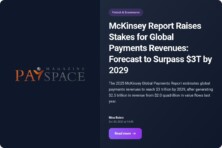Wall Street is betting that Federal Reserve Chairman Jerome Powell at the central bank’s annual confab in Jackson Hole, Wyoming, will confirm the intention of the United States financial regulator to decide on monetary easing, implying cutting interest rates.

At the same time, there is currently no definitive understanding of the extent to which the Fed is ready to take measures as part of actions to lower the cost of borrowing. It is highly likely that the central bank of the United States in this case will not be involved in what can be described as sharp moves, the impact of which is focused on some kind of broad changes. The Fed is very cautious about the potential easing of the current monetary policy conception. Over the past two years, the central bank of the United States has pursued what can be called an aggressive strategy. The Fed has been gradually raising interest rates as part of efforts to counteract the inflationary process. Currently, the cost of borrowing in the United States is 5.25%-5.5%. The corresponding figure corresponds to a 23-year high in a kind of newest history of US borrowing costs. It is also worth noting that a consensus position was reached among officials of the central bank of the United States, according to which, before deciding to start cutting interest rates, maximum confidence should be formed that inflation is on a steady trajectory toward the Fed’s 2% target. In general, the US economic system is currently in good condition, but the sudden increase in the unemployment rate in July to 4.3% after 4.1% a month earlier was a signal or a kind of warning that the present state of affairs is not ideal and the short-term prospects should not be characterized as unambiguously positive. Also, the mentioned suddenness is indicative from the point of view that the easing of the monetary policy of the central bank of the United States is not something that will necessarily be implemented in reality and which you just need to wait for. Also, the growing tension in the space of the system of geopolitical relations, contributing to economic uncertainty at the global level, continues to be a factor of pressure on many central banks, including the Fed.
Most likely, for stock traders in the United States, the main state will be indecision. To a certain extent, the corresponding attitude can be characterized as logical against the background of a lack of understanding of the scale of actions the US financial regulator is ready for in the context of monetary policy easing.
Eric Beiley, executive managing director of wealth management at Steward Partners Global Advisory, says that stocks will show a positive dynamic if statements are made in the short term about the Fed’s firm intention to start lowering borrowing costs. At the same time, the expert noted that the absence of such statements signaling the determination of the central bank of the United States regarding monetary policy easing would provoke a large sell-off.
From the point of view of understanding the future prospects of its dynamic, the current economic realities are extremely difficult for money managers who have recently been actively involved in the process of high-intensity investment in technology companies. The corresponding tendency was largely due to the so-called boom in artificial intelligence, which is on the trajectory of what can be described as a progressive technological evolution. As part of investing in technology companies, money managers sought to increase the S&P 500 index.
The markets are dominated by the expectation that the central bank of the United States will begin to make and subsequently implement decisions on monetary policy easing during its September meeting. At the same time, there is no guarantee that Jerome Powell will make a public statement about the intentions of the US financial regulator regarding interest rates. It is not necessary to exclude the possibility that, in the context of the relevant issue, he will choose in favor of the tactic of silence. If this choice is made, anxiety levels may increase in the markets. Moreover, it is worth noting that the tactic of silence is quite expected and even organic for Jerome Powell. The Chairman of the Fed has already formed a kind of practice in which he adheres to extreme caution and opts for generalized and to some extent abstract statements about what actions the US financial regulator plans to take as part of monetary policy easing. The appropriate tactics may be related to the lack of an unambiguous and definitively approved plan.
Eric Beiley says that the markets are currently demonstrating the maximum level of confidence that in the short term, the central bank of the United States will begin to implement measures to cut interest rates. The expert also noted that Jerome Powell’s silence, implying the absence of an official or relatively official statement of the relevant movement, would be a huge surprise. It is worth noting that currently there is no understanding of how the US financial regulator assesses the risks associated with potential market reaction options to the Fed’s decision to keep secret its intentions regarding monetary policy easing. Besides, it is unknown whether the central bank of the United States pays attention to such issues.
The excessive silence of the US financial regulator may provoke risks in terms of the prospects for further rapid growth of the S&P 500 index by $3.3 trillion. This indicator returned to the trajectory of moving forward after a global sell-off was observed in the first half of the current month amid increased concerns related to the prospects of the rise of the economy. Over time, the situation returned to normal. The stock market has been on a winning streak for seven sessions. In the week through Wednesday, August 14, according to EPFR Global data cited by Bank of America Corp., investors made financial injections worth $5.5 billion into US securities.
It is worth noting that increased concerns about the prospects for economic growth were associated with the above-mentioned sudden growth in the unemployment rate in the United States and the fact that the benefits of investing in the area of artificial intelligence were not as fast as many had assumed. Moreover, the realization has been actualized that the development of AI is a process focused on long-term progressive movement and does not have an unambiguous goal, since there is still no definitive understanding of the limits of the capabilities of digital thinking systems and the configuration that will become a kind of peak point of their evolution. Market sentiment was aggravated by disappointing earnings data from some technology companies, including, for example, Intel. The mentioned firm’s revenue was below analysts’ preliminary expectations.
Many Wall Street experts warn investors that they should not expect any unambiguous and absolutely specific statements from the chairman of the Fed about the intentions of the central bank of the United States in the context of monetary policy easing. Tom Hainlin, national investment strategist at US Bank Wealth Management, says Jerome Powell is unlikely to make very prescriptive remarks, given the experience of his previous Jackson Hole speeches.
Bill Dudley, former head of the New York Fed, says that the content of Mr. Powell’s expected statements will signal that there is no need for the US financial regulator to continue following a tight monetary policy. It is worth noting that the corresponding statements can be stated not in the format of a direct assertion, but in the form of a hint or some kind of indirect reasoning of a generalized nature. Bill Dudley does not expect Jerome Powell to report on the size of interest rate cuts. Also in this context, the expert noted that the central bank of the United States should consider the report on the state of affairs in the sphere of employment in August before deciding on lowering the cost of borrowing at the September meeting.
Bill Dudley is also of the opinion that the Fed made a mistake during the pandemic by committing to hold short-term rates at zero until the economy was deemed fully employed and inflation rose above 2% and was expected to remain at that level for some time.
Stephanie Lang, chief investment officer at Homrich Berg, says Jerome Powell’s tone is crucial. The expert also noted a high level of probability of a negative dynamic of the value of stocks if the Chairman of the Fed shocks the market and demonstrates a hawkish attitude. In this case, it implies statements about an increase in interest rates or a statement that maintaining an aggressive monetary policy strategy of the US financial regulator in the foreseeable future is the most appropriate course of action.
Traders are confident that at the September meeting of the US central bank, officials will decide to lower the cost of borrowing. At the same time, they do not know what the scale of the corresponding decision will be. In the coming days, not only Jerome Powell but also some other Fed officials will speak at public events. Traders are expecting these events. The corresponding expectations may be met with silence and the inability to form an understanding of the intentions of the US financial regulator in the context of monetary policy.
Currently, there is a widespread sentiment on Wall Street that the most difficult period of the current summer has been overcome. At the same time, this vision can rather be described as an assessment containing a significant share of hope. Traders expect that in the foreseeable future, there will be no turbulence in the market and a state of affairs that corresponds to what is called a collapse will not form. They are also betting on a decrease in the Cboe volatility index, which is currently close to its highest level since June 2022.
It is worth noting that traders have reduced their large bets on cutting interest rates in the United States in September. The corresponding actions were made against the background of signs of economic resilience.
The perceived market risk associated with Jackson Hole is declining, and investors no longer expect the United States central bank to take aggressive actions in the context of monetary easing, implying a sharp and large-scale lowering of borrowing costs. There is growing confidence that the current economic realities are not the environment of conditions and circumstances in which further interest rate increases or holding high levels of interest rates are necessary.
Tom Hainlin says that the current interest is focused on the Fed’s rate path, if it’s one cut per meeting or if it’s still data dependent on jobs and inflation prints. At the same time, the expert noted that Jerome Powell will probably not talk about this topic in his public speech.
The Fed Chairman’s speech at Jackson Hole is not traditionally what can be called a source of high-intensity processes in the stock market. At the same time, the corresponding speech can be significant or of increased importance if it precedes a meeting of the United States central bank on changes to the monetary policy concept with sensitive consequences for the economy. Since 2000, the S&P 500 has climbed 0.4% on average in the week following the gathering.
In August 2022, during a speech at Jackson Hole, Jerome Powell said that the United States central bank would need to maintain a restrictive monetary policy. He noted that the corresponding strategy of the Fed’s activities is appropriate due to the inflationary realities that the US financial regulator was counteracting. On that August day, the value of shares showed a decline of 3.4%. Then, over the week, the corresponding figure fell by another 3.3%. Traders remember this period, which was clearly not favorable for the market.
Currently, the prevailing view among investors is that the United States central bank has achieved its goal of providing the so-called soft landing of the economy. This point of view is based on the fact that the US financial regulator was able to cope with the rapid growth of the cost of goods and services and at the same time was able to avoid serious economic problems. Against the background of these achievements of the Fed, it is logical and natural to expect that the dynamic situation will be positive. In this case, this means the prospects for changing the state of affairs in the space of the United States economic system. At the same time, the US financial regulator continues to adhere to the tactics of silence, which generates various assumptions about potential probabilities.
The Fed will hold three more policy meetings before the end of the current year. There is a widespread belief among traders that the US central bank’s response to the weakening labor market will be lowering the cost of borrowing. In their opinion, the realism of this assumption is associated with significant prospects for inflation to return to the target level of 2%.
The so-called core consumer price index in the United States, which excludes food and energy costs, increased 3.2% in July from a year ago. The dynamic of the mentioned figure indicates that the expenses of US residents continue to be at a high level. This circumstance means that the US central bank can pursue a less aggressive monetary policy.
Stephanie Lang says that Jerome Powell doesn’t need to scare markets. According to the expert, the Fed Chairman needs to give confidence that inflation is ebbing and officials are comfortable with bringing restrictive rates to a more neutral level.









